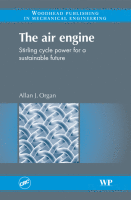Browse content
Table of contents
Actions for selected chapters
- Full text access
- Book chapterAbstract only
1 - The famous engine that never was
Pages 3-1 - Book chapterAbstract only
2 - What Carnot efficiency?
Pages 13-28 - Book chapterAbstract only
3 - Counter-flow spiral heat exchanger – Spirex
Pages 29-38 - Book chapterAbstract only
4 - A high-recovery-ratio combustion chamber
Pages 39-2 - Book chapterAbstract only
5 - The regenerator problem brought down to size
Pages 55-66 - Book chapterAbstract only
6 - The regenerative annulus and shuttle heat transfer
Pages 67-76 - Book chapterAbstract only
7 - The rotating-displacer air angine
Pages 77-93 - Book chapterAbstract only
8 - The strange case of the self-regulating air engine
Pages 94-106 - Book chapterAbstract only
9 - Some light on the inner workings of the ‘thermal lag’ engine
Pages 107-131 - Book chapterAbstract only
10 - New correlations for old
Pages 135-146 - Book chapterAbstract only
11 - Regenerator thermal analysis – unfinished business
Pages 147-160 - Book chapterAbstract only
12 - Flow passage geometry
Pages 161-178 - Book chapterAbstract only
13 - Beyond the performance envelope
Pages 179-191 - Book chapterAbstract only
14 - For the sceptic
Pages 192-208 - Book chapterAbstract only
15 - Scaling – and the neglected art of back-of-the-envelope calculation
Pages 211-225 - Book chapterAbstract only
16 - ‘How to make a business out of Stirling engines today’
Pages 226-251 - Book chapterNo access
Appendix I - Draft Patent Specification – Improvements in or relating to Stirling engines and ‘hot-air’ engines
Pages 252-256 - Book chapterNo access
Appendix II - Crank mechanism kinematics
Pages 257-259 - Book chapterNo access
Appendix III - Equilibrium or ‘temperature-determined’ picture of thermal lag engine
Page 260 - Book chapterNo access
Appendix IV - Tribal wisdom
Page 261 - Book chapterNo access
References and bibliography
Pages 262-267 - Book chapterNo access
Index
Pages 268-276
About the book
Description
Two centuries after the original invention, the Stirling engine is now a commercial reality as the core component of domestic CHP (combined heat and power) – a technology offering substantial savings in raw energy utilization relative to centralized power generation. The threat of climate change requires a net reduction in hydrocarbon consumption and in emissions of 'greenhouse' gases whilst sustaining economic growth. Development of technologies such as CHP addresses both these needs.
Meeting the challenge involves addressing a range of issues: a long-standing mismatch between inherently favourable internal efficiency and wasteful external heating provision; a dearth of heat transfer and flow data appropriate to the task of first-principles design; the limited rpm capability when operating with air (and nitrogen) as working fluid. All of these matters are explored in depth in The air engine: Stirling cycle power for a sustainable future. The account includes previously unpublished insights into the personality and potential of two related regenerative prime movers - the pressure-wave and thermal-lag engines.
Two centuries after the original invention, the Stirling engine is now a commercial reality as the core component of domestic CHP (combined heat and power) – a technology offering substantial savings in raw energy utilization relative to centralized power generation. The threat of climate change requires a net reduction in hydrocarbon consumption and in emissions of 'greenhouse' gases whilst sustaining economic growth. Development of technologies such as CHP addresses both these needs.
Meeting the challenge involves addressing a range of issues: a long-standing mismatch between inherently favourable internal efficiency and wasteful external heating provision; a dearth of heat transfer and flow data appropriate to the task of first-principles design; the limited rpm capability when operating with air (and nitrogen) as working fluid. All of these matters are explored in depth in The air engine: Stirling cycle power for a sustainable future. The account includes previously unpublished insights into the personality and potential of two related regenerative prime movers - the pressure-wave and thermal-lag engines.
Key Features
- Contains previously unpublished insights into the pressure-wave and thermal-lag engines
- Deals with a technology offering scope for saving energy and reducing harmful emissions without compromising economic growth
- Identifies and discusses issues of design and their implementation
- Contains previously unpublished insights into the pressure-wave and thermal-lag engines
- Deals with a technology offering scope for saving energy and reducing harmful emissions without compromising economic growth
- Identifies and discusses issues of design and their implementation
Details
ISBN
978-1-84569-231-5
Language
English
Published
2007
Copyright
Copyright © 2007 Woodhead Publishing Limited. All rights reserved.
Imprint
Woodhead Publishing
